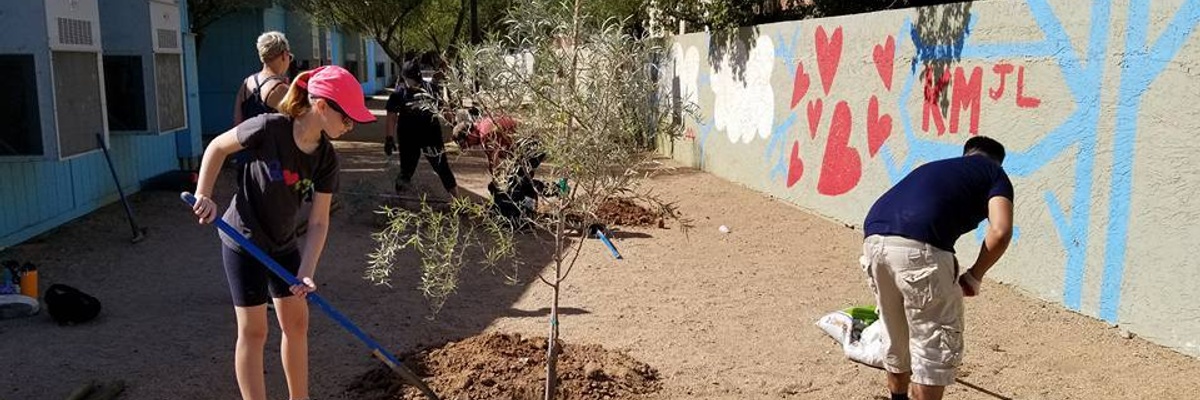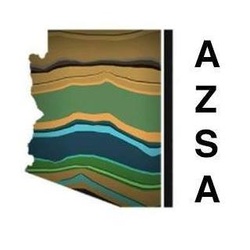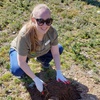Build your Team
Planting trees is an opportunity to engage with lots of people in your neighborhood and getting a strong team onboard from the outset will be critical to your success. One of the most important parts of your 30 Day Challenge is building your team and getting them together to kick-start this project. These are just some things to keep in mind as you get your team together:
Your organizing team will ideally include:
- An arborist or other tree expert (who can advise on tree species, specimens, and planting locations) - If you don't have this expertise in your group, AZSA can help give you this advice or connect you with someone else who can provide this advice.
- Someone who can be there on the day to do a safety training and tree planting demonstration - AZSA can also help with this if needed.
- If you are running a social media campaign to either gather volunteers or to publicize the planting after it occurs, you may want a dedicated person or two to work on this. You may also want someone who can document the event (photos, video, blogging, etc).
- For a tree planting of 25 trees, ideally you would have 5-6 people who have planted trees before and can either help do a planting demonstration or at least act as a team leader and give additional information/corrections to volunteers.
- If you are pre-digging holes for volunteers, determine special equipment needed and a person who can safely run that equipment.
- At this stage, it's also helpful to identify local groups you may want to involve (neighborhood associations, community organizations, etc.) These may help you to recruit volunteers later in the process but will also be a helpful ally in getting the project off the ground.
You'll need approximately 1.5-2 volunteers per tree for the day of the planting. You don't need to have all of these on board from the initial planning stages but keep in mind where and how you might recruit these volunteers as you plan and get your initial organizing team together.
Set a Goal & Research
Once you have your organizing team together, you'll need to decide on the goals of your tree planting project - discuss with your team why you are interested in doing this planting and decide on what you want to accomplish, or what you want to improve in your neighborhood.
One of the most critical considerations in undertaking this project is the planting location - based on the purposes of the planting, determine where to look for a planting location and set out some requirements as to how it will be selected. For example, if you want to increase walkability, you will want to look for areas where there is room for trees that could help cool/shade a walkway/street. If you want to increase trees in parks, you will need to look for parks in your area that have room to plant additional trees. If you want to increase tree canopy overall, you may want to look at a tree shade map (see below).
An important part of choosing a suitable location is getting to know / working along with the property owner. Maybe you already have a location & property owner in mind? What do they think of your project and what concerns or challenges do they have that affect the project? What are the needs of the property and how do they intersect with your goals?
Research
Does your City have an urban forestry master plan that your planting might further and align with?
Here are some examples of Forestry Plans in Arizona:
Tempe Urban Forestry Plan
This is a good resource for information about desert-adapted trees that are good choices for the Phoenix metro area. It includes information on naming and quantifying the community benefits of those trees. The info in this report can be used outside of Tempe, but it’s also a good idea to see if your city has a similar master plan with even more customized information. This can help you wrap your private planting into the City’s broader goals.
This is the Phoenix Tree and Shade Master Plan
This is an Interactive Shade Map
At this stage, it's also good to do some research into where you might source tools and trees locally. Often, you can borrow tools from a tool library or tool bank, this eliminates waste associated with buying tools if you don't plant to use them again in the future or do some research on local nurseries where you can purchase your trees.
Agreement with Property Owner
Some things to consider to reach agreement with your Property Owner
Talk to your Arborist
An Arborist or a tree consultant can help you choose suitable tree specimens from your local nursery and also advise you on planting locations
You should decide where you will source your trees and make sure tree expert can go to pick out the specimens at least 1 month in advance. Don’t forget to ask about delivery cost and timing options
Once you've made a decision on the size of trees you can decide whether holes will be pre-dug and which tools will be needed (don’t forget a caliche or digging bar) - these are both important decisions for your Planting Day plan!
- Determine if irrigation is an issue and whether that will be solved by the planting project or separately by the property owner prior to planting
- Make sure to discuss ongoing maintenance with the owner. Generally, the owner would take on responsibility for any ongoing maintenance including watering, trimming etc.
- Once the needs of the owner and project are met, the agreement between you and the property owner can be summarized in a short document, like a Memorandum of Understanding, to ensure clarity on both sides of the scope and impact of the project. AZSA can help you to draft this if necessary.
Plan your Planting Day
Your planting day will be a fun day out for all of your team and you'll finally get to see all your hard work in planning and research pay off!
- Schedule in Fall or early spring (avoid the coldest and hottest months; give trees at least a month between planting and hottest time of year)
- Organize an event on your ChangeX page and share it widely so that people in your neighborhood know it's happening and can come along to help out on the day. Consider sharing it through your social networks or any other local network/communication channels you have.
- Make sure to have 1.5-2 volunteers per tree for the day of the planting
- If you have the above volunteers available, plan to be at the site for 4 hours - about one hour of set-up (tree delivery, placement, tool delivery, food/water set-up, etc), 2-2.5 hours of planting, and 0.5-1 hour of clean-up.
- Make sure volunteers include people who have planted trees before that can act as team leaders, helping check on volunteers who have not done this before
- Secure a volunteer that can give a demonstration at the beginning of the event, both in safety and in proper tree planting technique
- Plan to provide some water and snacks for volunteers. (This helps people remember to drink water and take breaks when they need to.)
- Determine method of recruiting/communicating with volunteers
- Don’t forget to get utilities and irrigation marked before digging!
- Think about the property you are planting on when designing the project. (Are there streets you will need to close for volunteer safety? Is parking going to be an issue? Are you planting outside of operating hours of the location, as to require additional staff on site from a business or organization? Are you planting at individual homes? Will the homeowners be there?)
- You’ll also need to get a waiver of liability signed by each of the volunteers for the planting day- this is something AZSA can help with if you haven’t worked on something similar before.
Ongoing maintenance
Typically the responsibility for ongoing maintenance would lie with the property owner so make sure this is something you discuss as part of your agreement
Watering Advice
The information below is for desert-adapted trees. This means trees like palo verde, palo blancos, acacias, eucalyptus, and desert willows. If you are planting a new tree, the amount of water it takes will vary as it grows and what season it is. See the below table for estimates of how much to water a tree, so that it is watered to a depth of about 3 feet, based on its canopy size. We take a few of these numbers to create estimates for how much water the tree will need to be watered as it increases in size. It takes 2-3 years for trees to become established.
Newly planted:
Week 1: 1-2 days per week (summer) 3-4 days per week (winter)
Week 7: water every 7 days (summer) 10-14 days (winter)
After 8 weeks gradually increase the amount of days in between waterings until established
Below is an estimate for how many days the trees need to be watered once established. This is a high estimate, as some of these trees may need no water at all in certain years.
Established trees March - May: 14-30 days May - October: 7-10 days October - December: 14-30 days December - March: 30-60 days You can find much more detailed information from:
Arizona Municipal Water Users Association.
Water Use it Wisely









 "Welcome to Urban Forestry on ChangeX! We want to inspire and empower you to increase the trees in your neighborhood. Trees provide so many benefits for our communities and appropriate tree species and placement can maximize those benefits and minimize maintenance efforts. Share the benefits of trees with your community, find out here how to find a place and organize a tree planting.
"
- Aubrey Coffey-Urban, Arizona Sustainability Alliance
"Welcome to Urban Forestry on ChangeX! We want to inspire and empower you to increase the trees in your neighborhood. Trees provide so many benefits for our communities and appropriate tree species and placement can maximize those benefits and minimize maintenance efforts. Share the benefits of trees with your community, find out here how to find a place and organize a tree planting.
"
- Aubrey Coffey-Urban, Arizona Sustainability Alliance
